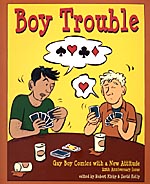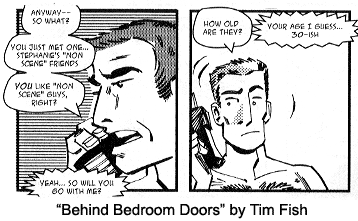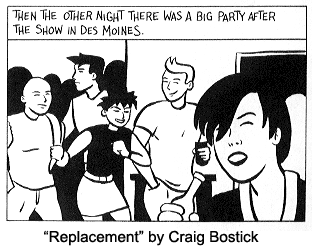 Edited by Robert Kirby and David Kelly
Edited by Robert Kirby and David Kelly
80 pages, black and white
Published by Boy Trouble Books, distributed by Top Shelf Productions
It’s hard to believe it’s been four years since the last issue of Boy Trouble was published. A gay-themed anthology, Boy Trouble‘s previous issues had a nice mix of humor and drama between its covers, spotlighting creators whose works you might never see otherwise. In the time since then, the Internet has really come into its own, making it suddenly much easier to find specific genres and styles of comic creators’s works. In this new techno-savvy world, it’s understandable if someone then asks if a book like Boy Trouble is really necessary. After reading the high level of quality the editors have assembled, you quickly realize that the answer is a resounding yes.
 It’s hard to pick a single favorite in the new Boy Trouble, but if I had to go to two contributions they’d be “Behind Bedroom Doors” by Tim Fish, and the assorted one-page strips by Craig Bostick. Fish’s story in many ways is the quintessential Boy Trouble story that I like to see; it’s fun to read, there’s some humor in it, but behind it are some pointed truths about what people say to others versus how they are behind closed doors, as well as different people’s approaches to dating. Fish’s art uses nice thick inks for a very strong and powerful art style, reminding me a bit of Walt Simonson’s work for Marvel back in the day. Fish uses zip-a-tone to a nice effect as well, letting its patterns form not just shadows but hair, patterned shirts, or anything else that strikes his fancy. It’s a nice, bold type of art, and I’m always ready to see more by Fish.
It’s hard to pick a single favorite in the new Boy Trouble, but if I had to go to two contributions they’d be “Behind Bedroom Doors” by Tim Fish, and the assorted one-page strips by Craig Bostick. Fish’s story in many ways is the quintessential Boy Trouble story that I like to see; it’s fun to read, there’s some humor in it, but behind it are some pointed truths about what people say to others versus how they are behind closed doors, as well as different people’s approaches to dating. Fish’s art uses nice thick inks for a very strong and powerful art style, reminding me a bit of Walt Simonson’s work for Marvel back in the day. Fish uses zip-a-tone to a nice effect as well, letting its patterns form not just shadows but hair, patterned shirts, or anything else that strikes his fancy. It’s a nice, bold type of art, and I’m always ready to see more by Fish.
Bostick’s one-page stories peppered throughout Boy Trouble remind me a lot of Jaime Hernandez’s work on Love and Rockets. It’s not just Bostick’s sleek ink line or use of blacks to really bring on his art, but the writing as well. In just six panels Bostick’s able to spin little vignettes of longing, and betrayal, and friendship that really hit home to their audience. There’s such a strong sense of mood in Bostick’s work that he’s able to do more in just a single page than many other people can do in entire books. As much as I love Bostick’s lighter works like Go-Go Girl, these one-pagers may be my favorite comics by him to date.
 That’s not to say that the rest of the book isn’t worth reading as well, mind you. Steve MacIsaac’s entry is one of the darker stories in Boy Trouble, as its protagonist finds himself in another circle of self-loathing behavior when looking for a good time. It’s a real contrast to most other stories in Boy Trouble, but its harsh words that the protagonist says to himself are ones that I think almost anyone who’s been on a string of less-than-ideal dates can relate to. In sharp contrast, Michael Fahy’s one-page stories are short, sweet, and hysterically funny; his “Learn to Argue the Mr. Fahy Way” alone is fantastic, as it carefully instructs people on how best to argue with people. With tips like “Try belittling your oppressor” and “zero in on one of your oppressor’s personality flaws and use it to link them to someone they dislike”, you know that it’s a perfect combination of humorous and deadly serious. Last but not least, Jennifer Camper’s “Saturday With My Sister” really made me sit up and take notice with its meandering through a young girl’s day as her older sister drags her into a “bad girl” world that she’s never seen before. Camper’s way of telling the story really does feel like she’s a little girl narrating her life, pulled into sneaking into movie theatres and having illicit alcohol passed around. A child’s perspective is hard to pull off when writing as an adult, but Camper nails it with the greatest of ease.
That’s not to say that the rest of the book isn’t worth reading as well, mind you. Steve MacIsaac’s entry is one of the darker stories in Boy Trouble, as its protagonist finds himself in another circle of self-loathing behavior when looking for a good time. It’s a real contrast to most other stories in Boy Trouble, but its harsh words that the protagonist says to himself are ones that I think almost anyone who’s been on a string of less-than-ideal dates can relate to. In sharp contrast, Michael Fahy’s one-page stories are short, sweet, and hysterically funny; his “Learn to Argue the Mr. Fahy Way” alone is fantastic, as it carefully instructs people on how best to argue with people. With tips like “Try belittling your oppressor” and “zero in on one of your oppressor’s personality flaws and use it to link them to someone they dislike”, you know that it’s a perfect combination of humorous and deadly serious. Last but not least, Jennifer Camper’s “Saturday With My Sister” really made me sit up and take notice with its meandering through a young girl’s day as her older sister drags her into a “bad girl” world that she’s never seen before. Camper’s way of telling the story really does feel like she’s a little girl narrating her life, pulled into sneaking into movie theatres and having illicit alcohol passed around. A child’s perspective is hard to pull off when writing as an adult, but Camper nails it with the greatest of ease.
Even the one or two stories that didn’t quite work for me still had something to recommend; Andy Hartzell’s “Leaving the Beast” seemed a little overly long in its retelling of the Beauty and the Beast classic, although Hartzell’s interpretation of a master/servant undercurrent in the story made me stop and think about the source material in a different way. Anonymous Boy’s story was artistically the weak link in Boy Trouble; it just didn’t seem as well-defined and mature as the rest of the works in the book, but it was almost appropriate for a story about high school crushes, and the writing was strong enough that in the end I was glad I sat down and read it.
All of these stories are just the tip of the iceberg in Boy Trouble, with 25 entries in all. There’s a lot of variety on display here, but the common theme is that everything in Boy Trouble is worthy of being there. Humor, drama, farce, and all points in-between are contained in Boy Trouble; it really was worth the wait. Hopefully once the editors recover we’ll see another volume before too long, because a world without Boy Trouble is a dull one indeed.
Purchase Links: Amazon.com
